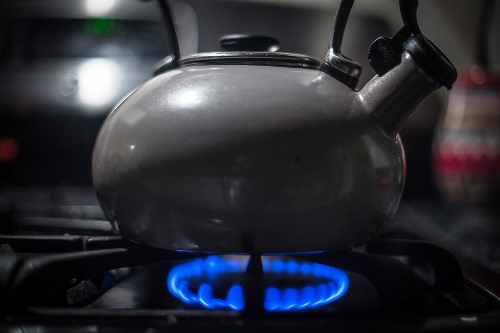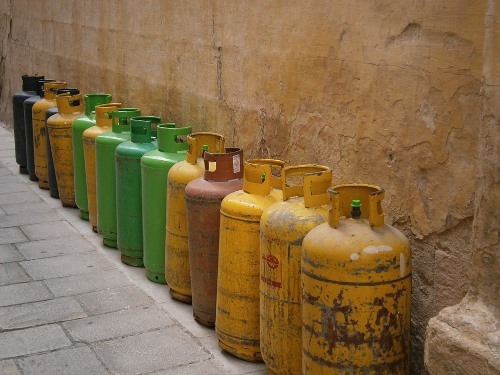|
Natural Gas for Cooking This information on natural gas for cooking will apply to almost any city in Bolivia.
You might be surprised to learn that most homes use natural gas for cooking in Bolivia. Some homes (mostly condos and apartments) have connections to gas that is piped in directly from the local company YPFB, but most homes that don’t use electric stoves and ovens must purchase canisters (called “garrafas”) as well as a valve-regulated hose (“manguera con válvula reguladora para garrafa”) that connects the gas canister to the stove/oven. There is no citywide gas grid to connect to (only some buildings and apartment complexes have their own grid). This might all seem very complicated and even frightening (for those of us that are used to using “electric everythings” and are afraid things might blow up) but it actually is extremely cost efficient, not that difficult at all, and with some basic common sense and precautions (see below), actually safe.
FOR HOMES WITH PIPED-IN GAS CONNECTIONS For homes that do have piped-in connections to gas, in order to get connected to gas in Santa Cruz, you will have to go to the local company YPFB (Yacimientos Petrolíferos Fiscales Bolivianos) in any city in Bolivia and request the connection. The government of Evo Morales nationalized the gas cooperatives in several cities in February 2009 so now YPFB (government-owned) is the only company that supplies natural gas. They will request identification from you and probably a copy of your rental contract, the last month’s gas bill (your landlord should have one), or a copy of last month’s electricity or water bill (again, ask your landlord) because these contain the location information they need in order to properly direct gas lines to your home. If your home has piped-in connections to YPFB (called "gas domiciliario" in Bolivia), you will have a constant supply of natural gas and won’t have to worry about purchasing canisters, hooking anything up, or running out of gas at inconvenient times. You will simply find a small lever on the wall somewhere near the space where your stove will fit in your kitchen. If you lift the lever up, it will cut off the gas supply to your stove. If you push it down it will begin the flow to your stove. You can regulate how high the flames burn on your stove or inside your over simply by moving the lever up and down until you find the level you are comfortable with. Then you leave it there. Use the knobs on our stove to regulate each burner individually. It's important for you to know whether or not the home you rent or buy has "gas domiciliario" connections or not, not only because you'll want to know if you'll need to buy gas in canisters, but also because most stoves and ovens you purchase at stores here have valves that are set up for canisters. If the home you rent or buy has "gas domiciliario", a YPFB technician will have to visit your home, take apart a portion of your stove or oven and replace the valves it contains with a set of different valves that are suited for the domestic gas network. Your one main inconvenience will be to always remember to have matches or a lighter on hand – matches run out and lighters run out of lighter fluid, even the large kitchen stove lighters you can buy at grocery stores, so basically you’ll have to remember to always have additional ones on hand. FOR HOMES THAT WILL USE GAS CANISTERS If your home has no piped-in gas connection, your job will be a little tougher but not as overwhelming as it seems. You’ll have to purchase your gas in garrafas every time you run out. For this, you must first purchase a brand new empty garrafa for gas (an initial investment of about Bs. 200-300). You can do this at local outdoor markets (just ask “donde hay garrafas?”) or small local stores around your neighborhood usually have some. Hardware stores of them stock them as well. Grocery stores do not supply garrafas.
With this empty garrafa you go to a gas sales location. You trade your empty garrafa for a full one. A full garrafa will cost you under $10 dollars. Depending on how much you cook or bake, it should last you 20-30 days, if not more! So as you can imagine, cooking with gas is MUCH CHEAPER than using electricity. In addition, throughout the day you might hear trucks honking a very shrill high-pitched horn as they make their way slowly from one street to the next through the neighborhoods. These are the gas trucks. They carry several dozen garrafas of gas and as they pass by your house you can flag them down (just wave), trade in your empty garrafa for a full one, and pay the driver or his assistants directly (in cash). We recommend you purchase two garrafas. That way you will always have a full one on hand and if you run out of gas while you're cooking or baking, buying a new one isn’t an emergency. Another option is to have your gas delivered, which usually takes a few hours between the time you call and the time it’s delivered. The gas company will do so if you call. However, you still have to trade your empty garrafa for the new full one. Garrafas weigh about 20 pounds when empty and are heavy to carry around. They weigh nearly 40 pounds when full, so save yourself the hassle. (Read the precautions below too). PAYING YOUR MONTHLY NATURAL GAS BILL If you have connections to gas in your home, you will be sent an “aviso de cobranza” or “pre-invoice” indicating how much you owe. You monthly bill must be paid in full each month at the local gas office (YPFB). Unlike other public utilities, there is only one credit union (we call them cooperativas) where you can pay your bill each month if you are far from the YPFB office. Your gas will be cut off if you are late paying your bills more than three months in a row. Typically, if used just for cooking and your water heater, your gas bill should be between Bs. 10-20 a month - that's less than $3 dollars! If you use gas canisters this does not apply to you as you will be paying in cash for your gas canister each time you replace it. COMMON SENSE AND BASIC PRECAUTIONS 1) They are heavy stainless steel canisters weighing a lot when empty and even more when full. Be careful when lifting them, ask someone to help you if needed, and be careful not to smash your toes when setting them down. If you are really fearful of using natural gas for cooking, you can purchase an electric stove and oven. Your electricity bill will probably increase by about $10 a month with the use of an electric stove, which isn’t too awful when compared to what we pay in the U.S. and other countries for electricity. However, keep in mind that in Bolivia only La Paz has 110V electricity. The rest of Bolivia uses 220V electricity - so it's not really worth bringing your electric stove or oven all the way from the US (where all electricity is 110V) unless you plan to live in La Paz. Everywhere else, it's best to purchase a stove in Bolivia.     |

